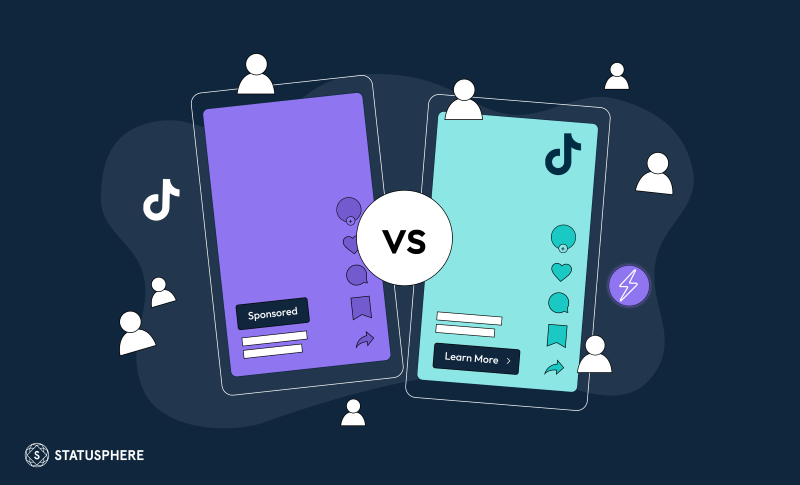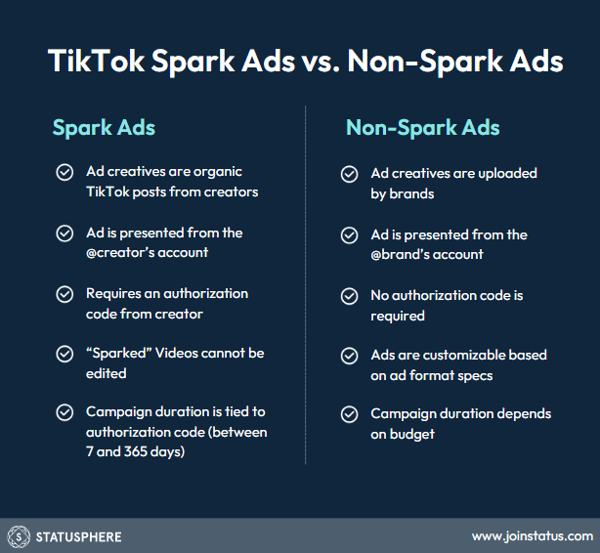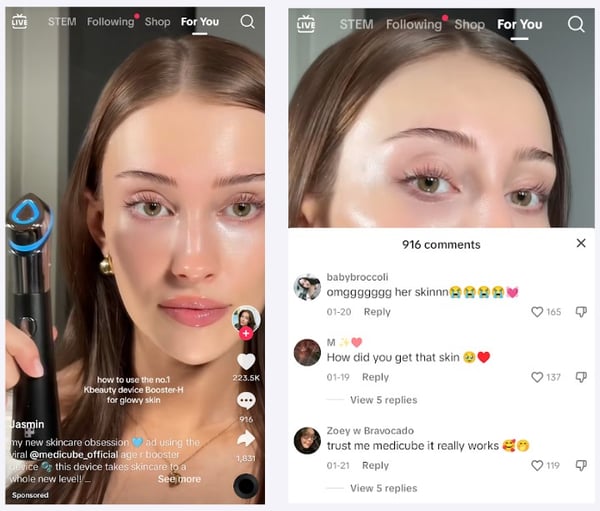
TLDR 👩🏫
- Spark Ads on TikTok turn creators' organic videos into sponsored content for brands
- Creating Spark Ads requires approval through a creator-generated ad code (which is shared with brands)
- While there are technically non-Spark creator ads, this approval process (AKA whitelisting or allowlisting) is exclusive to the Spark format
- Spark Ads are notable not only for their high performance versus other types of TikTok ads, but also the fact that they encourage collabs that benefit brands and creators alike
|
Be honest: can you tell the difference between a Spark Ad and a non-Spark Ad?
Chances are you’re seeing more UGC ads on your TikTok feed than ever before.
That’s because TikTok Spark Ads provide massive upside to brands and creators. Brands get to piggyback on creators' high engagement and those creators get paid.
It’s a win-win!
Still, it’s not always easy to distinguish between the types of creator-based ads across TikTok.
While they might look similar at a glance, the setup process and potential performance of TikTok creator ads are night and day. That’s why brands need to make the distinction.
This post digs into the differences and benefits of Spark Ads vs. non-Spark ads in plain English!
5 Key Differences Between TikTok Spark Ads vs. Non-Spark Ads
Given the ever-changing types of TikTok ads, there’s a lot we could talk about. But let’s keep it simple!
Below is a basic breakdown of how Spark Ads are different from non-Spark creator ads.
Note: By “creator ads,” we mean sponsored videos that feature actual people promoting products.

1. Spark Ads are actual TikToks that were published organically
Compare this to brand-generated ad creatives, dark posts or content from UGC creators which must be uploaded by brands themselves. These posts are “creator ads” and technically look the part but you’ll often notice a big difference in the performance of a true Spark Ad.
2. Spark Ads are presented through a creator’s @handle
Sparked videos resemble organic TikTok UGC except for a “Sponsored” or"Paid Partnership" label. This is the easiest way to tell the difference between Spark Ads and non-Spark ads.
3. Brands cannot edit the videos they run as Spark Ads
This includes creative details like captions, descriptions or video length. That said, brands can promote the same video multiple times. Granted you have the appropriate content usage rights.
4. Spark Ads require a TikTok video authorization code
This is another big distinction. Spark Ad video codes are creators’ way to permit brands to run their content as ads. Brands must obtain a unique authorization code for every video they promote.
5. How long a Spark Ad runs is based on a creator's code
Most non-Spark ads give brands free reign over campaign duration. In most cases, how long you run your TikTok ads is tied to your goals and budget.
However, Spark Ads are different because your campaign duration is tied to your authorization code. Creators can set their ad authorization from anywhere from 7 days to 365 days. TikTok defaults this duration to 30 days.
Are Spark Ads More Effective Than Non-Spark Creator Ads on TikTok?
The short answer? In most cases, yes!
Spark Ads are synonymous with “creator ads” but there are also examples of brands running ads from their @handles using dark posts or user-generated content that look like Spark Ads.
And hey, that’s totally fine! We're all for more creators in ads no matter how they get there.
But the high performance of legit Spark Ads illustrates how the format outshines other UGC ads.
Because while brands can present their ads as actual UGC, consumers can tell the difference.
Shoppers want to see products in the hands of real people. Since Spark Ads are tied to actual TikTok accounts and authentic creators, shoppers feel more confident in making purchases.
Peek the comments section of any given Spark Ad and chances are you’ll see enthusiastic shoppers who genuinely want to learn more. Done right, sponsored content can earn high engagement rates.
For reference, check out the Spark Ad example below which earned hundreds of thousands of likes.

The numbers don’t lie, either. Beyond what we’ve seen firsthand, TikTok has consistently been hyping up the high performance of Spark Ads vs. non-Spark ads.
What Are the Benefits of TikTok Spark Ads for Brands?
Spark Ads might seem like a cheat code for better ad performance on TikTok.
The reality, though? The benefits of Spark Ads and why they work so well are pretty straightforward:
- Spark Ads are served to specific, highly-targeted TikTokers based on the audience(s) of your creators. In short, these ads get seen by people who are legitimately interested in them.
- Brands can piggyback on creators’ high organic engagement. TikTok notes that interactions and engagements earned from a boosted video get attributed to your Spark Ad promotion.
- Brands can validate their Spark Ads before running them. If a creator’s video goes viral organically, chances are it’d be a great candidate to be sparked. This helps brands run TikTok ads with more confidence.
- Saved time spent on ad creatives. As noted in our recent UGC advertising panel, many brands are testing dozens of ad creatives per week. You don’t have to spend a second fine-tuning or editing videos with Spark Ads since brands receive them as-is.
- Done right, Spark Ads don’t feel like ads! Simple as.
What are the Benefits of TikTok Spark Ads for Creators?
Brands aren’t the only ones that benefit from the Spark Ads. A few notable wins for running Spark Ads on the creator side:
- Spark Ads give creators more upside and opportunities to monetize their TikTok videos.
- The boom of influencer ads raises the bar for all creators in terms of authenticity and promoting relevant products to their audiences.
- Spark Ads incentivize better promotional content and creativity to get the attention of brands and shoppers alike.
Here’s a quick video explaining how Spark Ads work for creators (and how Statusphere can help creators get more collabs, too):

Source
Again, a key difference between Spark Ads and non-Spark ads is the expectation to compensate creators for providing access to their content.
For example, brands that run Spark Ads with Statusphere’s platform can purchase instant TikTok authorization codes with rates set by creators. This eliminates back-and-forth negotiations while empowering brands to run ads ASAP and keeps creators happy.
How to Set Up and Scale Spark Ads on TikTok
There’s a reason why more and more brands are rushing to run Spark Ads.
Spoilers: they work! Like, really well.
One of the biggest benefits of Spark Ads vs. non-Spark ads is the speedy setup process. Given that ads are based on actual videos, brands save countless hours typically spent editing ad creatives.
That said, getting Spark Ad codes from more than a handful of creators at a time can be a time-sink if you’re trying to manage the process manually.
And that’s why we built instant Spark Ad codes into our software.
With Statusphere’s micro-influencer platform, brands can turn their top influencer content into Spark Ads in just two clicks. You can purchase ad codes directly from creators based on their personal rates.
-1.png?width=500&height=490&name=SparkAds-1%20(1)-1.png)
This hands-off process likewise makes it easier to scale TikTok ads by saving brands time bouncing between platforms. With all of your content and ads in one place, you have a constant pulse on the performance of your influencer marketing strategy.
Want to learn more about how our software works? Get in touch with our team of experts to see how we can scale your influencer campaigns and Spark Ads in a fraction of the time.
